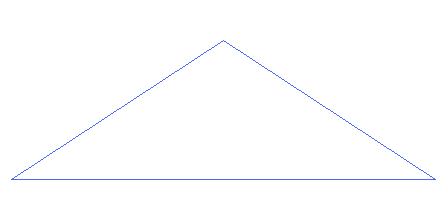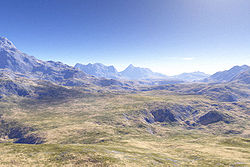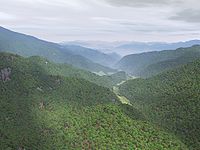
Fractal landscape
Encyclopedia

Stochastic
Stochastic refers to systems whose behaviour is intrinsically non-deterministic. A stochastic process is one whose behavior is non-deterministic, in that a system's subsequent state is determined both by the process's predictable actions and by a random element. However, according to M. Kac and E...
algorithm designed to produce fractal
Fractal
A fractal has been defined as "a rough or fragmented geometric shape that can be split into parts, each of which is a reduced-size copy of the whole," a property called self-similarity...
behaviour that mimics the appearance of natural terrain. In other words, the result of the procedure is not a deterministic fractal surface, but rather a random surface that exhibits fractal behaviour.
Many natural phenomena exhibit some form of statistical self-similarity that can be modeled by fractal surfaces. Moreover, variations in surface texture provide important visual cues to the orientation and slopes of surfaces, and the use of almost self-similar fractal patterns can help create natural looking visual effects.
The modeling of the Earth's rough surfaces via fractional Brownian motion was first proposed by Benoît Mandelbrot
Benoît Mandelbrot
Benoît B. Mandelbrot was a French American mathematician. Born in Poland, he moved to France with his family when he was a child...
.
Because the intended result of the process is to produce a landscape, rather than a mathematical function, processes are frequently applied to such landscapes that may affect the stationarity
Stationary process
In the mathematical sciences, a stationary process is a stochastic process whose joint probability distribution does not change when shifted in time or space...
and even the overall fractal behavior of such a surface, in the interests of producing a more convincing landscape.
According to R. R. Shearer
Rhonda Roland Shearer
Rhonda Roland Shearer is an American sculptor, scholar and journalist, who founded the nonprofit organization Art Science Research Laboratory with her late husband Stephen Jay Gould. The mission statement avows that the lab aims to "infuse intellectual rigor and critical thinking in disciplines...
, the generation of natural looking surfaces and landscapes was a major turning point in art history, where the distinction between geometric, computer generated images and natural, man made art became blurred.
Behaviour of natural landscapes


Natural landscape
A natural landscape is a landscape that is unaffected by human activity. A natural landscape is intact when all living and nonliving elements are free to move and change. The nonliving elements distinguish a natural landscape from a wilderness. A wilderness includes areas within which natural...
s behave in a generally fractal manner has been the subject of some research. Technically speaking, any surface in three-dimensional space has a topological dimension of 2, and therefore any fractal surface in three-dimensional space has a Hausdorff dimension
Hausdorff dimension
thumb|450px|Estimating the Hausdorff dimension of the coast of Great BritainIn mathematics, the Hausdorff dimension is an extended non-negative real number associated with any metric space. The Hausdorff dimension generalizes the notion of the dimension of a real vector space...
between 2 and 3. Real landscapes however, have varying behaviour at different scales. This means that an attempt to calculate the 'overall' fractal dimension of a real landscape can result in measures of negative fractal dimension, or of fractal dimension above 3. In particular, many studies of natural phenomena, even those commonly thought to exhibit fractal behaviour, do not in fact do so over more than a few orders of magnitude. For instance, Richardson's examination of the western coastline of Britain showed fractal behaviour of the coastline over only two orders of magnitude. In general, there is no reason to suppose that the geological processes that shape terrain on large scales (for example plate tectonics) exhibit the same mathematical behaviour as those that shape terrain on smaller scales (for instance soil creep).
Real landscapes also have varying statistical behaviour from place to place, so for example sandy beaches don't exhibit the same fractal properties as mountain ranges. A fractal function, however, is statistically stationary, meaning that its bulk statistical properties are the same everywhere. Thus, any real approach to modeling landscapes requires the ability to modulate fractal behaviour spatially. Additionally real landscapes have very few natural minima (most of these are lakes), whereas a fractal function has as many minima as maxima, on average. Real landscapes also have features originating with the flow of water and ice over their surface, which simple fractals cannot model.
It is because of these considerations that the simple fractal functions are often inappropriate for modeling landscapes. More sophisticated techniques (known as 'multifractal' techniques) use different fractal dimensions for different scales, and thus can better model the frequency spectrum behaviour of real landscapes
Generation of fractal landscapes
A way to make such a landscapeLandscape art
Landscape art is a term that covers the depiction of natural scenery such as mountains, valleys, trees, rivers, and forests, and especially art where the main subject is a wide view, with its elements arranged into a coherent composition. In other works landscape backgrounds for figures can still...
is to employ the random midpoint displacement algorithm
Diamond-square algorithm
The diamond-square algorithm is a method for generating highly realistic heightmaps for computer graphics. It is a slightly better algorithm than the three-dimensional implementation of the midpoint displacement algorithm which produces two-dimensional landscapes...
, in which a square
Square (geometry)
In geometry, a square is a regular quadrilateral. This means that it has four equal sides and four equal angles...
is subdivided into four smaller equal squares and the center point is vertically offset by some random amount. The process is repeated on the four new squares, and so on, until the desired level of detail is reached. There are many fractal procedures (such as Perlin noise
Perlin noise
Perlin noise is a computer-generated visual effect developed by Ken Perlin, who won an Academy Award for its use in the motion picture Tron...
) capable of creating terrain data, however, the term "fractal landscape" has become more generic.
See also
- Brownian surfaceBrownian surfaceA Brownian surface is a fractal surface generated via a fractal elevation function.For instance, in the three-dimensional case, where two variables X and Y are given as coordinates, the elevation function between any two points and can be set to have a mean or expected value that increases as the...
- BryceBryce (software)Bryce is a 3D modeling, rendering and animation program specializing in fractal landscapes. The name is taken from Bryce Canyon—a rugged region with many of the same landscapes that were first simulated with the software.- History :...
- Diamond-square algorithmDiamond-square algorithmThe diamond-square algorithm is a method for generating highly realistic heightmaps for computer graphics. It is a slightly better algorithm than the three-dimensional implementation of the midpoint displacement algorithm which produces two-dimensional landscapes...
- GromeGromeGrome is an environmental modeling package developed by Quad Software dedicated for procedural and manual generation of large virtual outdoor worlds suitable for games and other 3D real-time simulation applications.- History :...
- OuterraOuterraOuterra is a planetary 3D engine in development by the Slovakian team of Brano Kemen, Laco Hrabcak and Tomas Mihalovic since 2008. The engine renders high-quality terrain, terrain texturing, flora and water flow normal maps using relatively sparse and highly compressed data through fractal...
- TerragenTerragenTerragen is a scenery generator program for Microsoft Windows and Mac OS X developed and published by Planetside Software. It can be used to create renderings and animations of landscapes.-History:...
External links
- Fractal landscapes
- 3D Fractal Mountains in Java
- Landscape Studio Java-based terrain generator
- MDTerrain Terrain Generator using Midpoint Displacement
- A Web-Wide World by Ken Perlin, 1998; a Java applet showing a sphere with a generated landscape.

